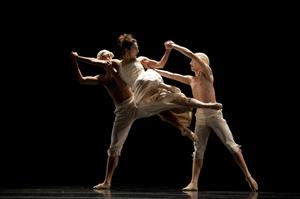Every program, really, is Peter Boal’s “Director’s Choice.” It’s now six years into his reign as artistic director of Pacific Northwest Ballet and today’s audiences are reaping the fruits of his vision and labor. The risks Boal has taken in recent years (challenging his dancers/audiences with everything from live singing in the “West Side Story Suite” to overt adult material from Ulysses Dove) haven’t been without bumps. Yet cumulatively, these rule-bending exercises have morphed Pacific Northwest Ballet into a troupe of fearless physical creatures— and surely one of the very best companies working on any dance stage today.
That said, the company has not been spared worrying economic drama. Last spring PNB hustled to cover a $350,000 budget gap — longtime donors stepped forward with a challenge grant — and this year’s season offerings are taut and lean. Some of their programs this year, like the current mixed repertory bill, have only seven scheduled performances.
Onstage, the energy remains one of undiminished exuberance and bounty. At the 2010-2011 season opener last week, the company inhabited a range of biological and cultural landscapes that ranged from Enlightment-era brilliance and chaos (Jiri Kylian’s pieces) to timeless travails in Spanish farm fields (Nacho Duato) to a strange ’80s-era aerobic society with hopeful chinks (Jerome Robbins).
In lesser hands, Lord knows, this mix could have left the audience with malaise or whiplash. Under Boal’s tutelage, however, the three-act evening coalesced into a deep, hopeful imperative.
“Petit Mort,” the 1991 Kylian ballet that debuted to such enthusiasm on last year’s “Director’s Choice” bill, only looks better over time. A wholly unique creation, “Petit Mort” is a movement study in which Kylian uses the limbs of 6 men, 6 women, and 6 fencing foils to draw a series of primordial body contours and relationships. There is something very bug-like in the lexicon (jointed legs, arms extended into curves like antennae, foils creating tripedal stepping patterns) while the energetic tone is suspended, rubbery, or piercing. When the men put down their foils, the women cling to their own formidable carapaces ( black dresses sewn on fiberglass shells). By piece end, foils and dresses are playfully exchanged during a series of extraordinary sculptural duets. You could even call them moltings.
And here we pause for some bawdy regression — the Seattle debut of “Sechs Tänze (Six Dances),” a second work from Kylián’s acclaimed Black-and-White series.
A swinging, episodic romp created in 1986, “Sechs Tänze” (pictured) presents an animated crew of head-wagging, hand-wringing women and ribald men straining and collapsing into each other, and their environment. They crash and cling to each other, mishandle the foils and dresses from “Petit Mort,” and send filthy plumes of wig powder drifting through the air. In the midst of this disintegration, Chalnessa Eames and Carrie Imler, carryovers from the “Petit Mort” cast, anchor the piece brilliantly. Their womanly depth gives the lightening frenzy a semi-human center. They’re both such good actors, too – one expects the demon barber Sweeney Todd to join either one in song at any moment (“It’s man devouring man, my dear …”)
“Jardí Tancat,” Nacho Duato’s intimate suite for six dancers (created 1983), fills the second act of the program, gently restoring the power of vocabulary and form to the stage. Like Martha Graham and Alvin Ailey, Duato builds distinct characterization from a handful of thwarted, yearning postures. Set to a tape of Catalonian folk songs by Maria del Mar Bonet, the dance and the dancers seem to merge, with some actors — like Arianna Lallone — becoming inseparable from their roles. Lallone’s seminal work here is as fierce as her original debut over a decade ago — from the first sight of her extra-long torso arching and crumpling to the heaving swoosh of skirt fabric pressed against her extra-long legs. Kiyon Gaines is also bringing a masterful presence to this work now.
The last act of the evening, Jerome Robbins’ “Glass Pieces,” brings us squarely back to America (back when America still had some personality). Created in 1983 for New York City Ballet, while Boal was a young dancer there, the work’s tableaux of spandexed pedestrians marching to Philip Glass was met with half-hearted appreciation at its initial premiere in New York. In his program notes, Boal explains that company director George Balanchine was dying in the hospital while Robbins was creating this work, and that the premiere of “Glass Pieces” occurred just two weeks after Balanchine’s death.
Robbins’ image of a single couple emerging from the physical static — a perfect bubble of suspended form and content — reads now like an elegant testimonial to dance and partnership and union. Not exactly a Balanchine eulogy (Robbins’ “In Memory Of…” speaks more directly to Balanchine himself), “Glass Pieces” seems more like a rebuff of inertia, isolation, death.
The charge of men that storms the stage in the third section, led by the incomparable James Moore, repeatedly leap with an unpointed forward foot. There is something amiss, yes, but they are adaptive.
They continue to fly. And multiply. And intersect with the team of female dancers that have swept onstage. And the piece that began with isolated anonymous pedestrians ends with a company, united as one, dancing at the height of its power.
[This piece originally ran on Crosscut.]
